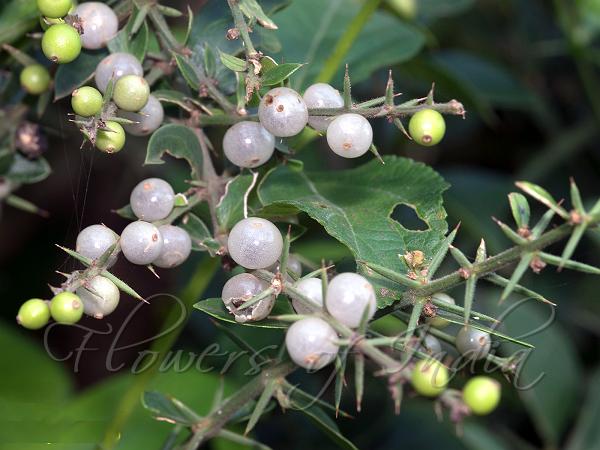|
| Needle Bush |
|

|

| File size | 447585 |
| Original date | 9/3/17 9:46 AM |
| Resolution | 1600 x 1200 |
| Flash | Flash did not fire, auto |
| Focal length | 150.0mm |
| Exposure time | 1/60s |
| Aperture | 13.0 |
| Focus Distance | |
| Metering Mode | Spot |
| Camera make | NIKON CORPORATION |
| Camera model | NIKON D800 |
| Sensor type | OneChipColorArea |
|
|
|
|
Photo: |
Botanical name: Azima tetracantha Family: Salvadoraceae (Salvadora family)
Synonyms: Azima spinosissima, Azima nova, Azima angustifolia
Synonyms: Azima spinosissima, Azima nova, Azima angustifolia
Needle Bush is a rambling shrubs with spines in
leaf-axils, usually 4, straight, up to 2.5 cm, grooved, branchlets
tetragonous, velvet-hairy. Leaves are oppositely arranged, 3 x 2 cm,
ovate, with a fine point, base blunt, margin thickened, leathery,
nerves 3 pairs near the base; leaf-stalk up to 5 mm. Flowers are tiny,
borne in spikes in leaf-axils and at branch-ends, up to 10 cm long.
Flowers are clustered, white, unisexual; bracts 2 x 1 mm, ovate,
mucronate, velvet-hairy; calyx 1 mm, bell-shaped, bilobed,
velvet-hairy; petals 4, 2 x 1 mm, oblong; stamens 4, free, alternating
with petals, filaments 1 mm, anthers 1 mm, pistillode absent. The fruit
is a spherical green to white berry around 5-10 mm in diameter,
containing 1-2 seeds. Needle Bush is found throughout the Paleotropics,
including India.
Medicinal uses: The sap of the plant is
applied directly to treat toothache and bleeding gums after tooth
extraction and also as a disinfectant. The roots are used in the
treatment of rheumatism, dropsy and stomach disorders. The pounded
roots are applied directly to snakebites, whilst an infusion is also
taken orally as a treatment for them. The root bark is used in the
treatment of rheumatism. The leaves are stimulant. They are eaten with
food as a treatment for rheumatism. The leaf juice is used in the
treatment of asthma and coughs caused by phthisis. The pickled leaves
are used as an appetizer and against colds. An infusion of the leaves
is used to treat venereal diseases. The crushed leaves are applied
directly to painful teeth, whilst the leaf juice is applied to the ears
to treat earaches. The juice of the berries is applied directly into
the ear to treat earache.
The sap of the plant is
applied directly to treat toothache and bleeding gums after tooth
extraction and also as a disinfectant. The roots are used in the
treatment of rheumatism, dropsy and stomach disorders. The pounded
roots are applied directly to snakebites, whilst an infusion is also
taken orally as a treatment for them. The root bark is used in the
treatment of rheumatism. The leaves are stimulant. They are eaten with
food as a treatment for rheumatism. The leaf juice is used in the
treatment of asthma and coughs caused by phthisis. The pickled leaves
are used as an appetizer and against colds. An infusion of the leaves
is used to treat venereal diseases. The crushed leaves are applied
directly to painful teeth, whilst the leaf juice is applied to the ears
to treat earaches. The juice of the berries is applied directly into
the ear to treat earache.
Medicinal uses:
 The sap of the plant is
applied directly to treat toothache and bleeding gums after tooth
extraction and also as a disinfectant. The roots are used in the
treatment of rheumatism, dropsy and stomach disorders. The pounded
roots are applied directly to snakebites, whilst an infusion is also
taken orally as a treatment for them. The root bark is used in the
treatment of rheumatism. The leaves are stimulant. They are eaten with
food as a treatment for rheumatism. The leaf juice is used in the
treatment of asthma and coughs caused by phthisis. The pickled leaves
are used as an appetizer and against colds. An infusion of the leaves
is used to treat venereal diseases. The crushed leaves are applied
directly to painful teeth, whilst the leaf juice is applied to the ears
to treat earaches. The juice of the berries is applied directly into
the ear to treat earache.
The sap of the plant is
applied directly to treat toothache and bleeding gums after tooth
extraction and also as a disinfectant. The roots are used in the
treatment of rheumatism, dropsy and stomach disorders. The pounded
roots are applied directly to snakebites, whilst an infusion is also
taken orally as a treatment for them. The root bark is used in the
treatment of rheumatism. The leaves are stimulant. They are eaten with
food as a treatment for rheumatism. The leaf juice is used in the
treatment of asthma and coughs caused by phthisis. The pickled leaves
are used as an appetizer and against colds. An infusion of the leaves
is used to treat venereal diseases. The crushed leaves are applied
directly to painful teeth, whilst the leaf juice is applied to the ears
to treat earaches. The juice of the berries is applied directly into
the ear to treat earache. | Identification credit: Shashidharswamy Hiremath | Photographed in Byadgi-Taluk, Haveri-Dist, Karnataka. |
• Is this flower misidentified? If yes,